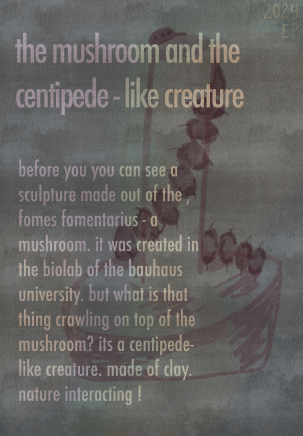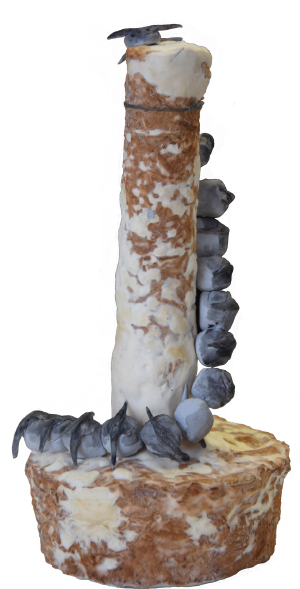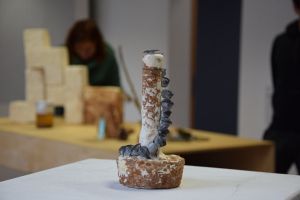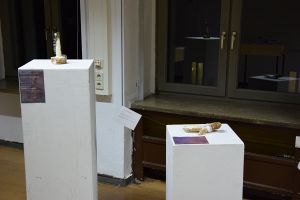(text changes) Tag: 2017 source edit |
(formating) |
||
| Line 3: | Line 3: | ||
[[File:Illustration.png|thumb|436x436px]] | [[File:Illustration.png|thumb|436x436px]] | ||
During the conceptualisation of my ideas, I thought about having the mushroom interact with nature, in particular with animals. | During the conceptualisation of my ideas, I thought about having the mushroom interact with nature, in particular with animals. However, to avoid the common image of the mushroom being eaten, I wanted the artwork to show the mushroom and the animal living together in peace, and I knew that I wanted a long creature to interact with the mushroom, to wrap itself around it, like a hug, so I decided to use centipedes as inspiration for the animal. For the mushroom, I opted for a slim shape, avoiding excessive thickness. The inspiration for the mushroom shape came from trees, but due to difficulties in creating a mould that resembled a tree, round plastic containers were used instead. One container was used as a base to represent the ground, while the other was placed on top to mimic a simplistic tree. The mushroom was then placed in the containers and after an initial failed attempt, it grew successfully. The two pieces were placed one on top of the other, allowing the mushroom to grow them together. The end product was more like a stump than a tree, but it was to my liking and I was happy that it worked the way I had imagined. Having achieved the desired shape for the mushroom, I left it to dry. Meanwhile, I crafted a centipede out of clay, which I selected as my I chose clay because I enjoy working with it and it seemed appropriate to use soil to create the natural component. Making the centipede itself wasn't difficult, but getting it to wrap around the mushroom and stay in place was a challenge - I ended up having to use string and a nail to keep it on the mushroom. | ||
However, to avoid the common image of the mushroom being eaten, I wanted the artwork to show the mushroom and the animal living together in peace, and I knew that I wanted a long creature to interact with the mushroom, to wrap itself around it, like a hug, so I decided to use centipedes as inspiration for the animal. | [[File:Png centipede.png|left|thumb]] | ||
For the mushroom, I opted for a slim shape, avoiding excessive thickness. The inspiration for the mushroom shape came from trees, but due to difficulties in creating a mould that resembled a tree, round plastic containers were used instead. | |||
Having achieved the desired shape for the mushroom, I left it to dry. | |||
Meanwhile, I crafted a centipede out of clay, which I selected as my I chose clay because I enjoy working with it and it seemed appropriate to use soil to create the natural component. Making the centipede itself wasn't difficult, but getting it to wrap around the mushroom and stay in place was a challenge - I ended up having to use string and a nail to keep it on the mushroom. | |||
Revision as of 18:10, 6 March 2024
Using the Fomes fomentarius mushroom, the aim of this project was to make a sculpture showing how the mushroom interacts with nature.
During the conceptualisation of my ideas, I thought about having the mushroom interact with nature, in particular with animals. However, to avoid the common image of the mushroom being eaten, I wanted the artwork to show the mushroom and the animal living together in peace, and I knew that I wanted a long creature to interact with the mushroom, to wrap itself around it, like a hug, so I decided to use centipedes as inspiration for the animal. For the mushroom, I opted for a slim shape, avoiding excessive thickness. The inspiration for the mushroom shape came from trees, but due to difficulties in creating a mould that resembled a tree, round plastic containers were used instead. One container was used as a base to represent the ground, while the other was placed on top to mimic a simplistic tree. The mushroom was then placed in the containers and after an initial failed attempt, it grew successfully. The two pieces were placed one on top of the other, allowing the mushroom to grow them together. The end product was more like a stump than a tree, but it was to my liking and I was happy that it worked the way I had imagined. Having achieved the desired shape for the mushroom, I left it to dry. Meanwhile, I crafted a centipede out of clay, which I selected as my I chose clay because I enjoy working with it and it seemed appropriate to use soil to create the natural component. Making the centipede itself wasn't difficult, but getting it to wrap around the mushroom and stay in place was a challenge - I ended up having to use string and a nail to keep it on the mushroom.
The final artwork depicts the centipede tightly wrapped around the mushroom. It is up to the viewer to interpret whether the mushroom and centipede are friends sharing a pleasant moment or if the centipede is imitating a snake, preparing to devour the mushroom as it crawls on top of it. However, what remains unchanged is that the mushroom and centipede are now forever connected.
This work was also presented in our exhibition "Design with Fungi and Slime Molds" during the Winterwerkschau.



